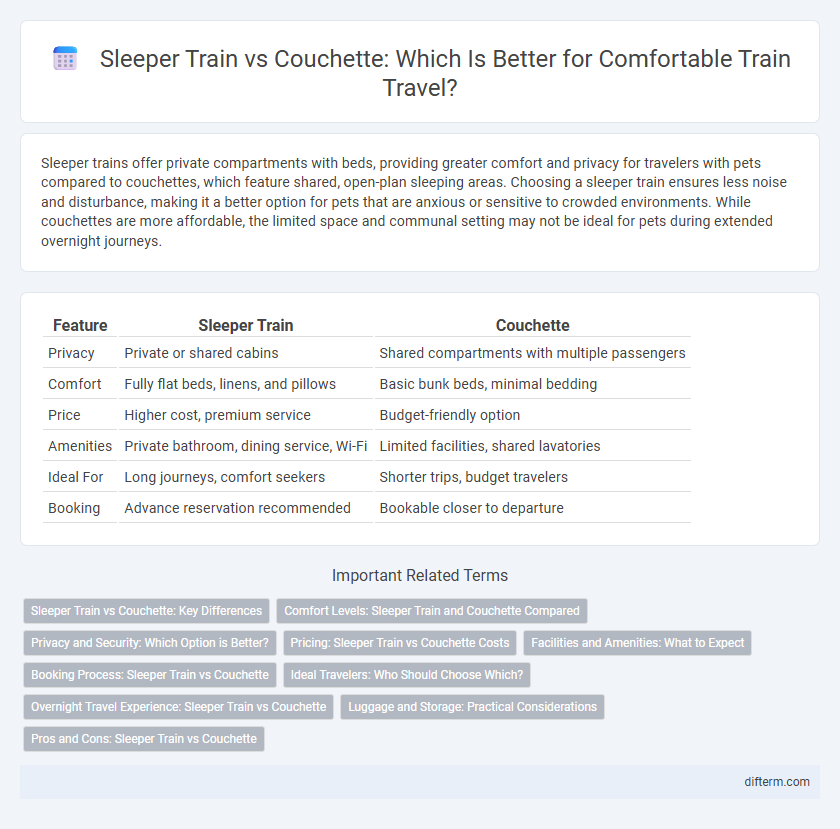Sleeper trains offer private compartments with beds, providing greater comfort and privacy for travelers with pets compared to couchettes, which feature shared, open-plan sleeping areas. Choosing a sleeper train ensures less noise and disturbance, making it a better option for pets that are anxious or sensitive to crowded environments. While couchettes are more affordable, the limited space and communal setting may not be ideal for pets during extended overnight journeys.
Table of Comparison
| Feature | Sleeper Train | Couchette |
|---|---|---|
| Privacy | Private or shared cabins | Shared compartments with multiple passengers |
| Comfort | Fully flat beds, linens, and pillows | Basic bunk beds, minimal bedding |
| Price | Higher cost, premium service | Budget-friendly option |
| Amenities | Private bathroom, dining service, Wi-Fi | Limited facilities, shared lavatories |
| Ideal For | Long journeys, comfort seekers | Shorter trips, budget travelers |
| Booking | Advance reservation recommended | Bookable closer to departure |
Sleeper Train vs Couchette: Key Differences
Sleeper trains provide private cabins with beds and often include amenities such as washbasins and en-suite bathrooms, offering increased comfort and privacy for overnight journeys. Couchettes are more affordable shared compartments with several berths, limited privacy, and basic facilities, ideal for budget travelers seeking economical travel. The choice between sleeper trains and couchettes depends on preferences for comfort level, budget, and travel experience during overnight rail trips.
Comfort Levels: Sleeper Train and Couchette Compared
Sleeper trains offer private compartments with fully reclining beds, providing maximum comfort and privacy for long-distance travel. Couchettes feature shared compartments with bunk beds, delivering a more economical but less spacious and quieter sleep environment. Comfort levels differ significantly, with sleeper trains catering to travelers seeking rest and seclusion, while couchettes suit budget-conscious passengers prioritizing affordability over luxury.
Privacy and Security: Which Option is Better?
Sleeper trains offer private compartments that enhance both privacy and security by limiting access to a small number of passengers and providing lockable doors, making them ideal for solo travelers or those seeking a quieter environment. Couchettes, with their open-plan shared bunks and communal spaces, may compromise privacy and increase exposure to theft or disturbances but provide a more social atmosphere at a lower cost. Travelers prioritizing safety and personal space often choose sleeper cabins over couchettes for overnight journeys across Europe and Asia.
Pricing: Sleeper Train vs Couchette Costs
Sleeper trains typically cost more than couchettes due to private compartments offering enhanced privacy and comfort, while couchettes provide shared, budget-friendly sleeping options. Pricing for sleeper cabins can range from $80 to $150 per night depending on the route and amenities, whereas couchette tickets often start around $40 to $70. Travelers seeking affordability choose couchettes, while those prioritizing comfort and space prefer sleeper trains despite the higher expense.
Facilities and Amenities: What to Expect
Sleeper trains offer private compartments with fully reclining beds, personal reading lights, and en-suite washrooms for enhanced comfort and privacy. Couchettes provide shared compartments with bunk beds, limited privacy, and shared washroom facilities, making them a budget-friendly option but with fewer amenities. Expect sleeper trains to include complimentary bedding, secure storage, and sometimes onboard dining, while couchettes typically offer basic bedding and minimal extras.
Booking Process: Sleeper Train vs Couchette
Booking a sleeper train involves selecting private compartments with beds, often offering more amenities and requiring advance reservations through specialized rail operators or online platforms. Couchette tickets are generally easier to book, providing shared sleeping berths in open compartments, available through national rail services with flexible options and lower costs. Both booking processes require secure passenger details, but sleeper train reservations may need early confirmation due to limited availability and higher demand.
Ideal Travelers: Who Should Choose Which?
Sleeper trains offer private compartments with beds, making them ideal for solo travelers, couples, or those seeking comfort and privacy during overnight journeys. Couchettes, featuring shared compartments with multiple bunks, suit budget-conscious travelers or groups who prioritize affordability over personal space. Families and social travelers often prefer couchettes for the communal experience, while business travelers typically opt for sleepers to maximize rest and productivity.
Overnight Travel Experience: Sleeper Train vs Couchette
Sleeper trains offer private compartments with beds and enhanced comfort, ideal for restful overnight travel, while couchettes provide shared cabins with bunk beds, catering to budget-conscious travelers seeking basic accommodation. The spaciousness and noise insulation in sleeper trains typically result in a more peaceful journey, whereas couchettes may involve more social interaction and reduced privacy. Choosing between the two depends on priorities like comfort level, cost, and the desired travel experience during overnight train journeys.
Luggage and Storage: Practical Considerations
Sleeper trains offer private compartments with secure luggage storage options, allowing travelers to keep their belongings close and organized throughout the journey. Couchettes provide shared compartments with limited storage space, often requiring passengers to store larger bags in designated luggage areas or under seats. For travelers carrying bulky or valuable items, sleeper trains deliver enhanced convenience and peace of mind with dedicated storage solutions.
Pros and Cons: Sleeper Train vs Couchette
Sleeper trains offer private compartments with beds, privacy, and comfort, making them ideal for long journeys but come at a higher price compared to couchettes. Couchettes provide budget-friendly shared compartments with bunk beds, suitable for travelers seeking economy and social interaction but with less privacy and basic amenities. Choosing between sleeper trains and couchettes depends on balancing cost, comfort, and travel experience preferences.
sleeper train vs couchette Infographic

 difterm.com
difterm.com